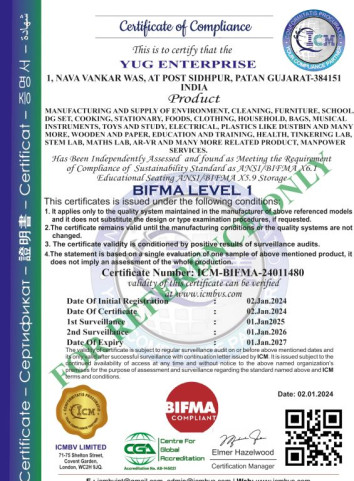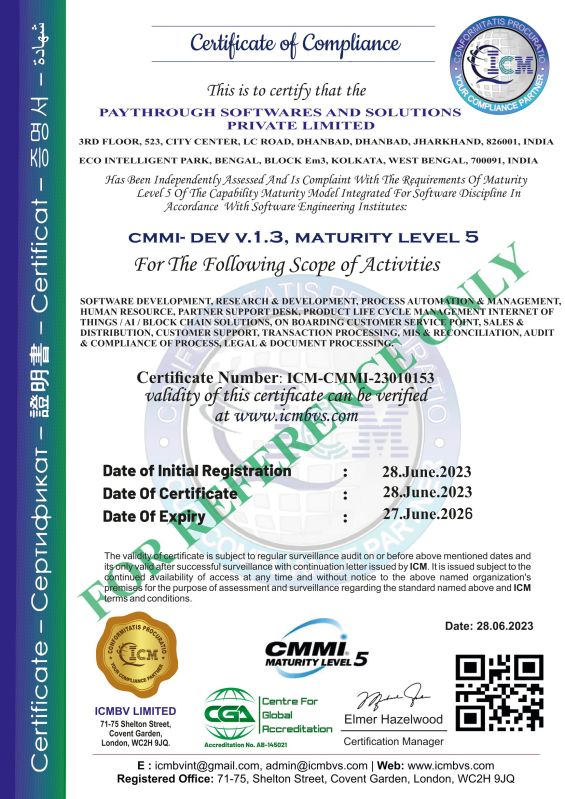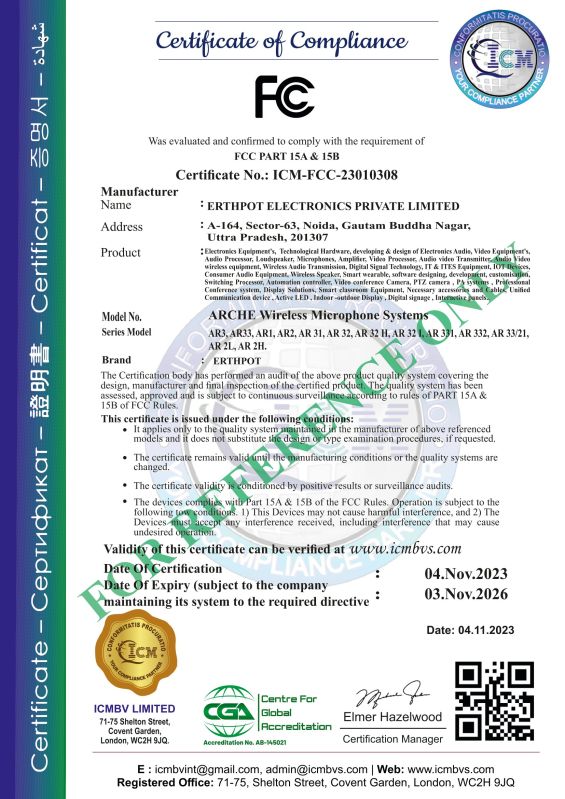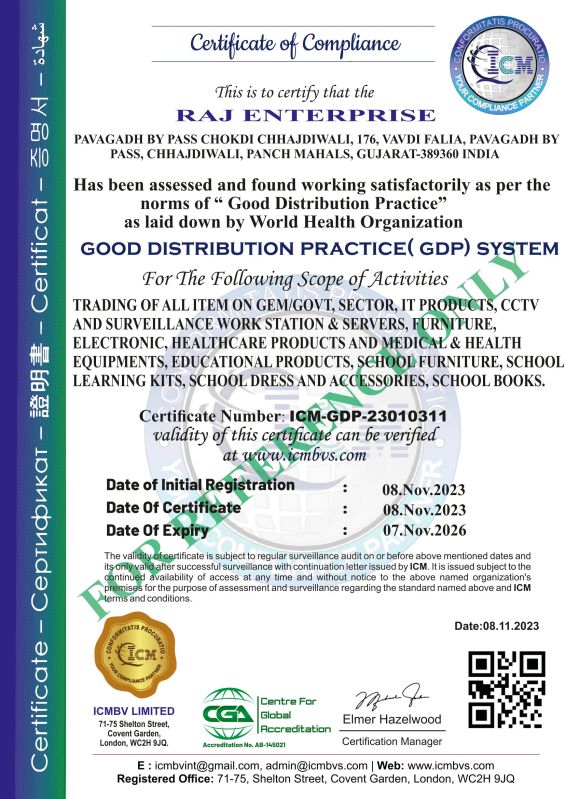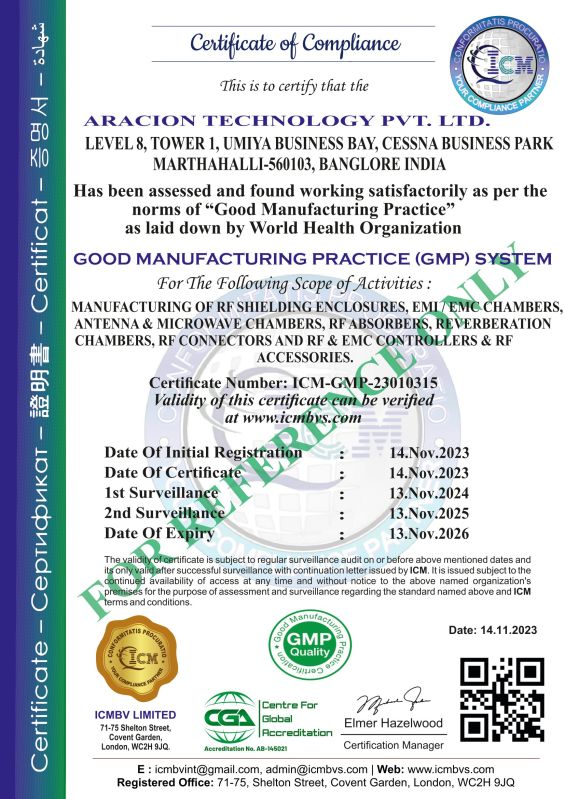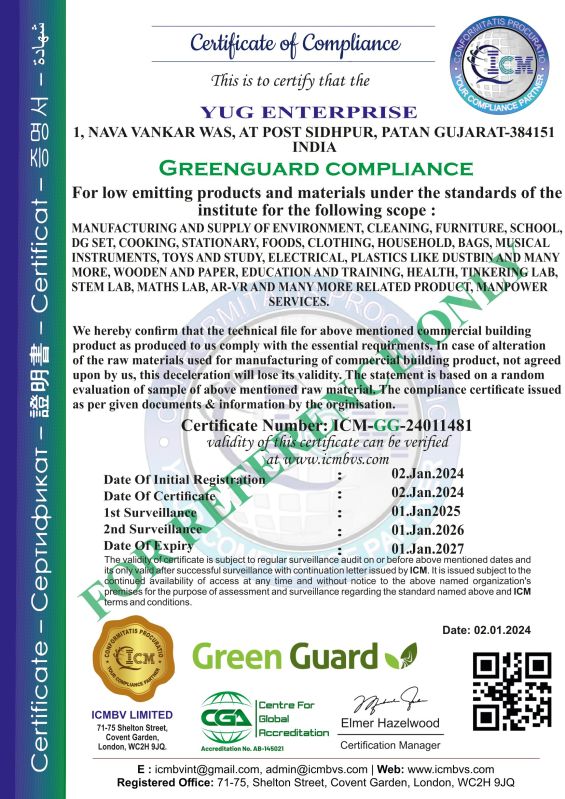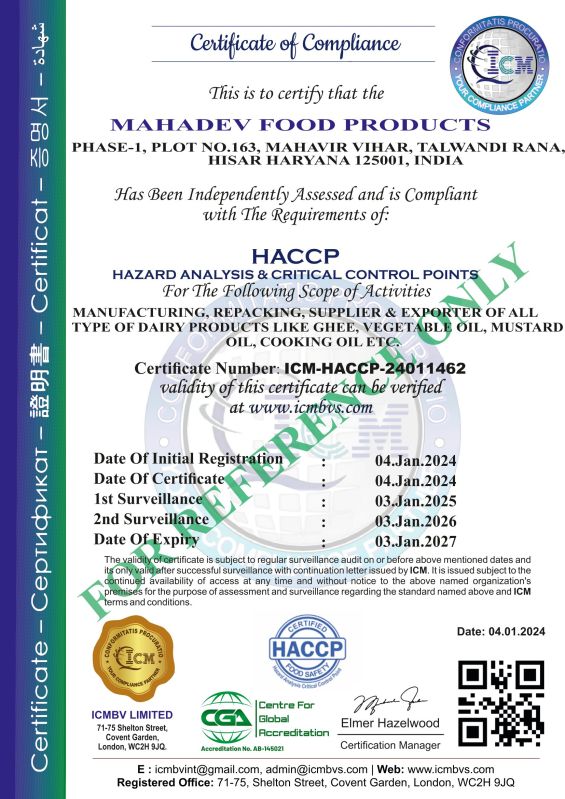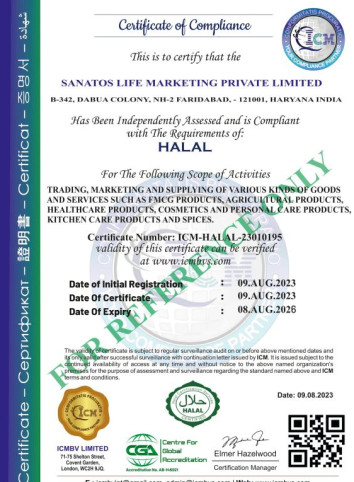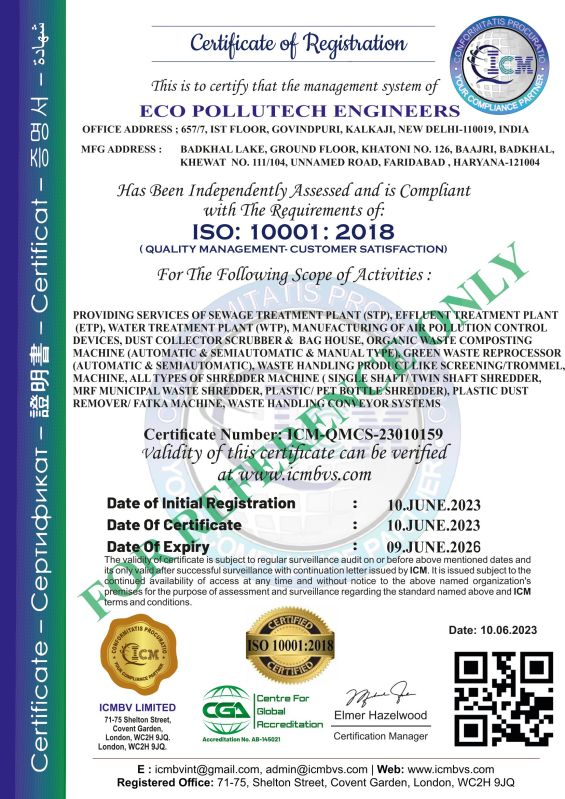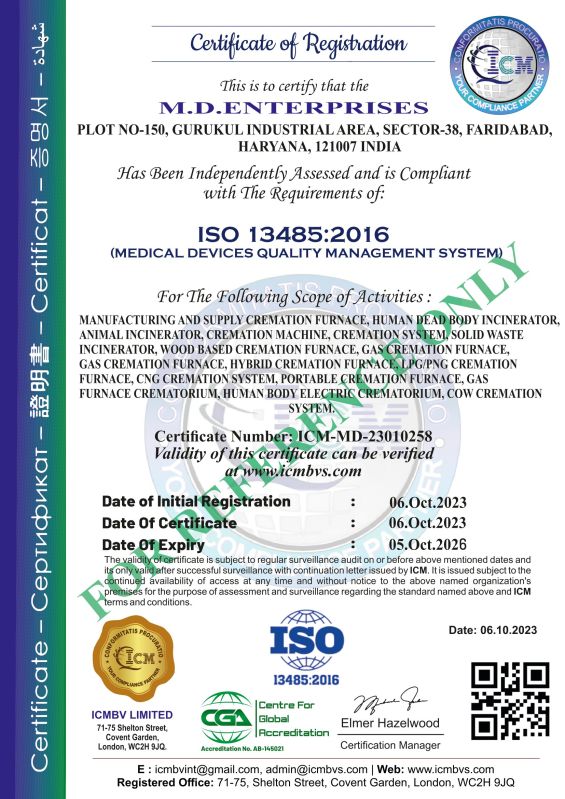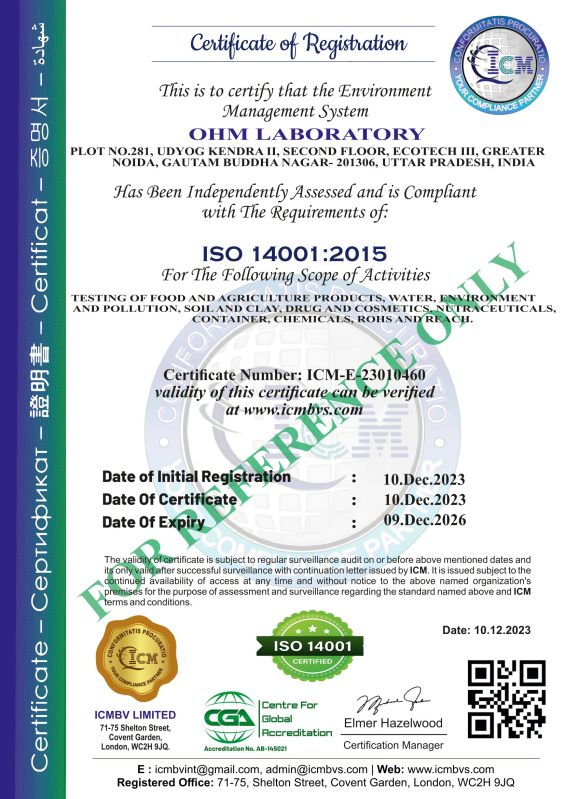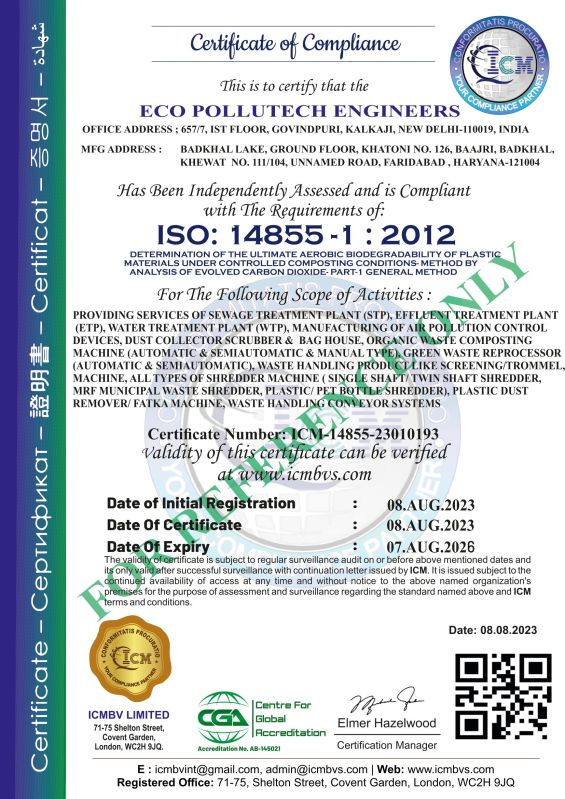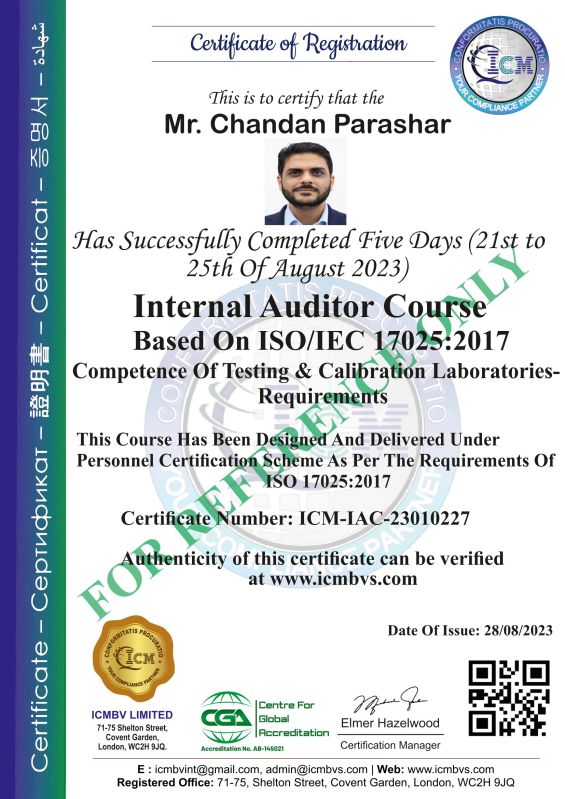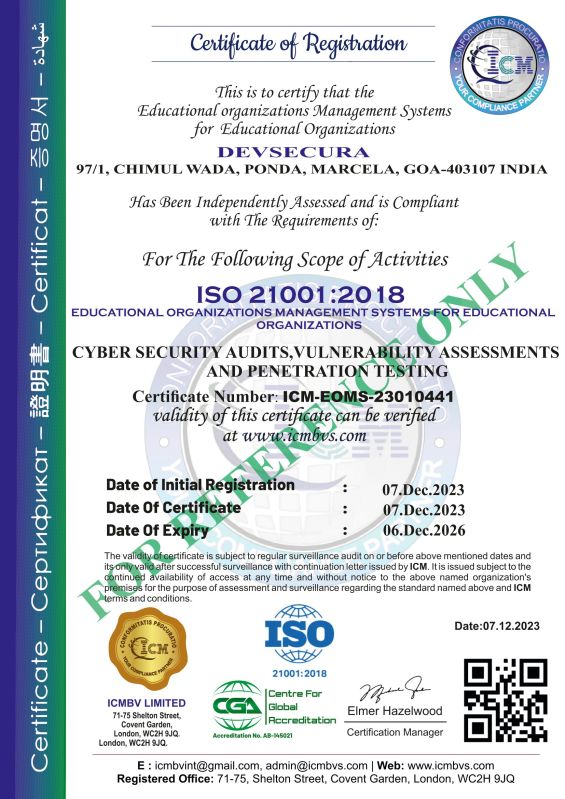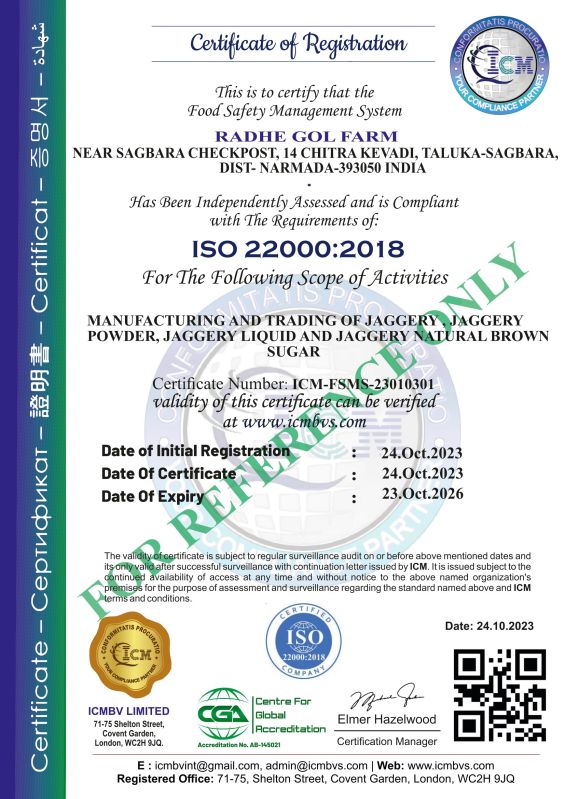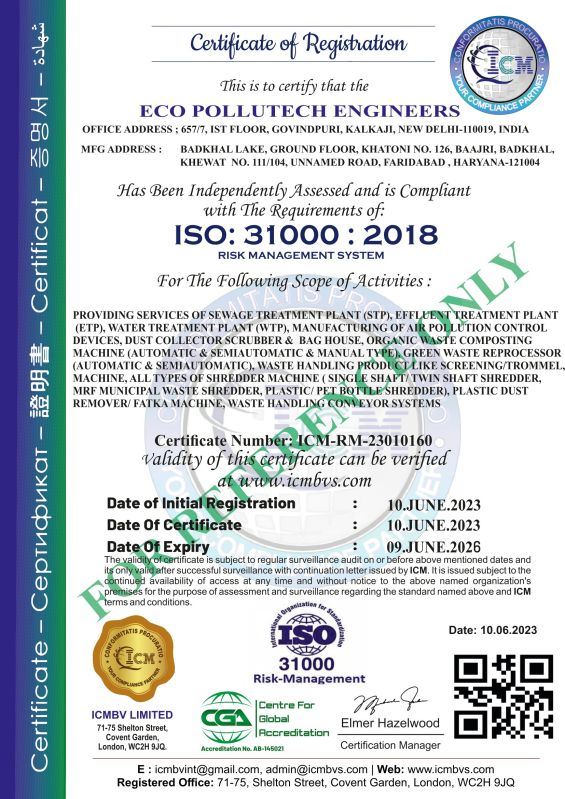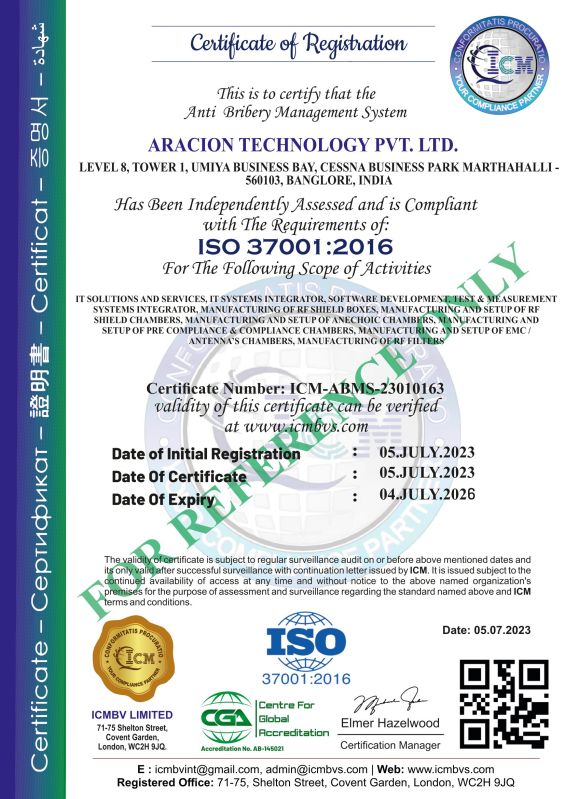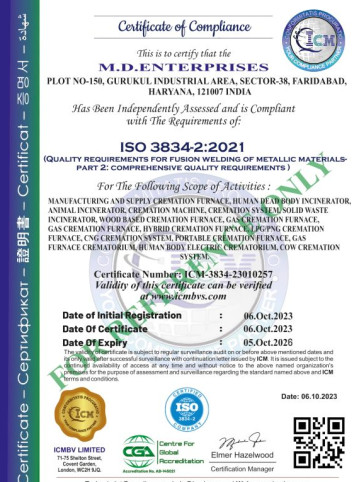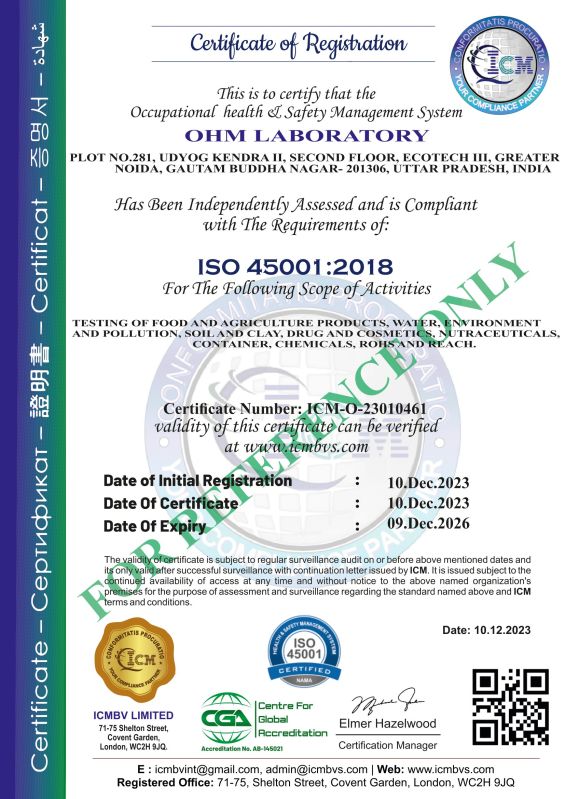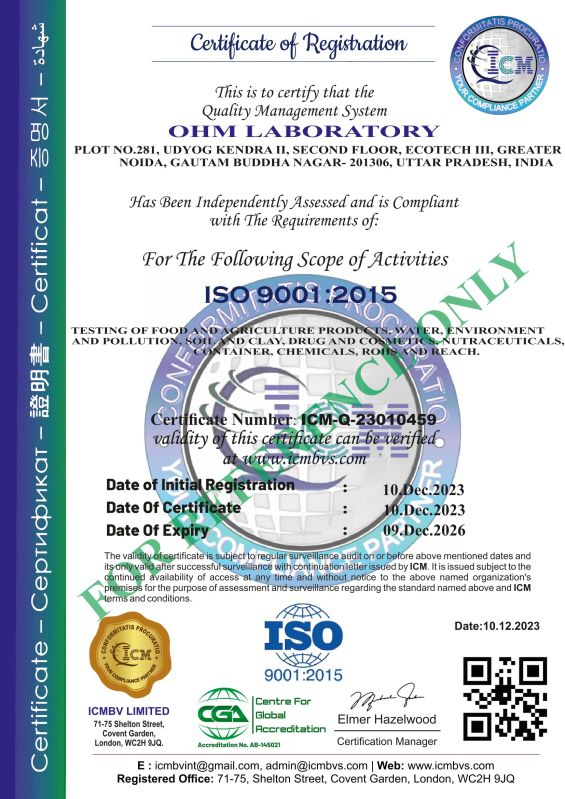- Ghaziabad, Uttar Pradesh
- GST NO. : 09AAWCA1337R1ZT
- View Mobile Number
Certification Services
Leading of Bifma Certification Service, CMMI Certification Service, FCC Certification Service, FSSC 22000 Certification Service, GDP Certification Service, GMP Certification Service, Greenguard Certification Service, HACCP Certification Service, Halal Certification Service, IEC 61010-1:2010 Safety Requirement Certification Service, ISO 10001:2018 Certification Service, ISO 13485:2016 Certification Service, ISO 14001:2015 Certification Service, ISO 14855-1:2012 Certification Consultancy Service, ISO 17025:2017 General Certification Service, ISO 21001:2018 Certification Service, ISO 22000:2018 Certification Service, ISO 31000:2018 Certification Service, ISO 37001:2016 Certification Service -, ISO 3834-1:2021 Certification Service, ISO 45001:2018 Certification Service and ISO 9001:2015 Certification Service from Ghaziabad.
What is BIFMA Certification?
To retain your office furniture year after year without any wear and tear obtaining BIFMA Certification for your organization to increase the shelf life of your furniture.
BIFMA Business and Institutional Furniture Manufacturers Association established in 1973, is the not-for-profit trade association developed by a joint committee of BIFMA by Unison process described by AMERICAN NATIONAL STANDARD INSTITUTE (ANSI). BIFMA Certification is a voluntary standard for business and institutional furniture manufacturers to administer and develop the furniture industry. It is generally engaged to lead, design, develop, advocate, advise and create models for the office and institutional furniture industry. The dependable and durability of office furniture keep offices running. BIFMA Certification addresses many things like Safety, Sustainability and social responsibility, Durability and strength, Recyclability and recycled content, Chemical content and emissions, Reliability, Overall quality, Flammability, and electrical components, Material, and energy efficiency, environmentally conscious design, Waste and water management.
Now, BIFMA certification is accepted as the parameter of furniture quality & safety that gives an effectual forum to achieve greater sustainability attributes. Manufacturers who receive the level certification mark are verifying that their policies and guidelines of providing the furniture world apply to BIFMA plans. A voluntary standardization of sustainable furniture and components are meeting the stringent requirements of the BIFMA standard. Organizations can choose the level of standard of BIFMA. By making a consistent improvement on their product an organization can also move their product to a higher level of conformance. BIFMA establishes certain furniture mark on the specific scale
- Materials
- Energy and Atmosphere
- Human and Ecosystem Health
- Social Responsibility
On these four criteria, the Manufacturer receives points on manufacturing facility and organization as a whole.
Level 1 Certification -32-44 points
Level-2 Certification -44-62 points
Level-3 Certification -63-100 points
Benefits for BIFMA Certification
BIFMA Certification benefits to an organization besides safety, such as:
- A high-quality and carefully tested furniture
- Ensures the durability and dependability of the product for many years
- Promote a healthy work environment
- Increases productivity
- Decreases work-related injuries
- An ongoing improvement in your Organization
- Carries a warranty of 5 years
- Mandates continuous monitoring
- Cheap rate with best services
- Internationally approved
Requirements of BIFMA Certification
Tested industries furniture needs to meet certain minimum requirements to comply with BIFMA Certification.
- Purpose for assessing Products according to BIFMA Standard
- Ensure successful conformance with the Standard
- Conducting testing of the Products
- Ensure efficient use of Materials
- Usage of Energy and atmospheric considerations
- Appropriate chemical constituents used in Furniture
- Ensure operations and maintenance of facilities used
- Prepare Product Conformance documents
- Conduct Internal Audit
Why your organization require BIFMA Certification?
Organizations with BIFMA Certification have gained the sustainability of their furniture for years and years by providing safety, durability, reliability, overall quality, flammability, and environmentally-conscious design and reduction in waste
What are CMMI Certifications?
CMMI is a popular Process Improvement Framework for organizations. It offers an end-to-end process roadmap for improving the company’s performance and achieving the best outcomes. Organizations that succeed with well-defined business processes receive CMMI certifications. The certification demonstrates their perseverance, efficiency, and capability. These certifications are highly valued and recognized by customers and partners worldwide.
List of Capability Levels
The CMMI Institute grants CMMI certifications as accreditations to global organizations. The certifications have different levels under the Capacity Level and Maturity Level. Here are the primary levels under each of these categories.
Capability levels
a) Capability level 0 represents an organization yet to develop a well-planned practice area.
b) Capability level 1 represents an organization that has started improving its operations at the initial level.
c) Capability level 2 represents an organization that follows a simple yet effective practice area plan with defined procedures.
d) Capability level 3 is for organizations that follow pre-defined industry standards to establish end goals.
Maturity levels
a) Maturity level 0 represents an organization yet to complete a project successfully.
b) Maturity level 1 is the initial level, representing an organization that has failed to meet deadlines or targets.
c) Maturity level 2 represents an organization stuck with unrelated activities apart from the execution process.
d) Maturity level 3 represents an organization that follows a standard approach. This organization overcomes ongoing challenges as per the deadlines.
e) Maturity level 4 represents an organization that follows a data-driven approach to meet the end project goals.
f) Maturity level 5 represents an organization that has improved continuously. It means that it has adapted to Changes faster and more efficiently.
What is CMMI Maturity Level 3?
It is the third level in the CMMI framework. At this level, organizations have well-defined and documented processes followed by all team members. The focus is improving operations with standardization. Customers and partners highly value CMMI Level 3 certification, indicating the organization has mature processes and can deliver high-quality products and services.
Benefits of CMMI Certification For Customer Satisfaction
a) Improved performance quality: CMMI certification indicates that the organization has well-defined processes. It is capable of providing high-quality solutions.
b) Predictable delivery: CMMI Level 3 certified organizations have matured and well-documented procedures. It ensures that the delivery of products and services is predictable and reliable.
c) Reduced risk: Organizations with CMMI certification have pre-defined processes for risk handling. Hence, the customers gain confidence in believing in them with the desired outcome.
d) Improve efficiency: This certification requires organizations to optimize their operational processes and workflow. It helps to improve overall productivity.
Fundamental Principles to Get CMMI Level 3 Certification
Achieving CMMI Level 3 certification isn’t just a piece of cake. Organizations require to follow certain principles to achieve CMMI Certification.
Establish a process improvement culture
This certification requires organizations to build a unique work culture focusing on continuous improvement. Hence, all team members should be committed to improving processes and eliminating waste.
FCC Certification ServicesWhat is FCC Certification?
The United States has required standards for products that might contribute to electromagnetic interference in order to reduce the level of radio frequency (rf) interference between electronic devices. Any electronic device or piece of equipment that is sold in the United States must not compromise the safety of the American public or interfere with other electronic products.The Federal Communications Commission (FCC) is in charge of the development, enforcement and implementation of regulations that Congress set forth in the Communications Act of 1934 and the Telecommunications Act of 1996. The FCC is an agency of the United States federal government that was created to regulate all forms of telecommunication inside of the U.S. including radio, television, digital cameras, Bluetooth, wireless devices and a broad gamut of RF electronics.When an electronic device has an FCC certificate, it means the product has been tested to comply with FCC standards and it has been approved. An FCC certification does not imply that the product is safe or durable. It simply means that it meets regulated limits for ionizing radiation. A certification does not imply that the device was manufactured any specific way. FCC approval can be granted as long as the electronic device meets FCC emission rules and regulations and has been tested to comply with FCC standards.
Compliance testing and requirements set by the Federal Communications Commission can seem extremely confusing. They can cause major frustration for manufacturers and electronic distribution companies. We can help your company better understand the process needed to gain an FCC certificate and help your product become certified to be sold in the United States.
What Products Require an FCC Certificate?
Radio frequency (RF) equipment that is sold or distributed in the United States is required to undergo testing in order to stay in compliance with standards set by the Federal Communications Commission under the EMC directive. Testing limits both intentional and unintentional electromagnetic radiation that is emitted from RF equipment in order to keep users safe. CSIA can help your company gain an FCC certificate for various types of RF emitting devices, including, but not limited to:
- electronic products
- mobile phones
- wireless local area networking equipment
- Bluetooth devices
- remote control transmitters
- land mobile radio transmitters
- wireless medical telemetry transmitters
- cordless telephones
- walkie-talkies
- electronic products
- Power adapters
- telecommunication equipment
- IT equipment
- electromagnetic compatibility products
- equipment and protective systems intended for use in potentially explosive
- atmospheres
- radio and telecommunications terminal equipment
What are FCC Regulations?
Federal Communications Commission standards depend on the type of radio frequency emitting device that is being tested. The FCC has come up with categories that identify what type of regulations and testing are necessary for different devices to obtain certified authorization for distribution. Testing is broken up into product categories including FCC Part 11, FCC Part 15, Part 18, Part 22, Part 24, Part 68, Part 90 and FCC Part 95. One of the most common types of device approval is for FCC part 15 certification, which refers to regulations set for television receivers.
The FSSC 22000 Scheme is a robust, ISO-based, internationally recognized certification scheme for auditing and certification of food safety for organizations in the food supply chain, regardless of size and complexity. This scheme, developed by Foundation FSSC, sets out requirements to develop, implement and operate a food safety management system. FSSC 22000 audit requirements are based on the existing standard ISO 22000:2018, relevant prerequisite programs (PRPs), technical specifications, and the FSSC Additional requirements.
Since February 2010 the FSSC 22000 Scheme has been recognized by GFSI (Global Food Safety Initiative) and since March 2021 has been endorsed as a sub-scope of the IAF MLA (International Accreditation Forum Multilateral Recognition Arrangement).
Benefits of FSSC 22000
Certification to FSSC 22000 demonstrates a commitment to food safety and delivers a variety of benefits that will impact different parts of your organization. FSSC 22000 benefits:
- Provides a systematic methodology to effectively identify and manage food safety risks
- ISO-based certification model can be used across the food supply chain
- Recognized by the GFSI
- Flexibility allowing you to determine how your business will meet the scheme requirements for the structure and documentation of your food safety management system
- Facilitates internal benchmarking and management through consistent application across multiple/international sites
- Promotes the review of and continual improvement of your food safety management system
- Shows your commitment to food safety, providing confidence to your customers
- Improved employee engagement, increasing awareness of food risks and promotion of safety Commitment to continuous improvement of the food safety system and its performance
What Are The Benefits?Managing Risk
First and foremost, building your food safety management system will provide your company with effective management of food safety hazards by creating an environment capable of producing safe product and a management system to continually manage, monitor, validate and improve the system.
Maintain Current Customers
Statistics show that approximately 1 out of 4 certified companies are asking their suppliers to achieve certification. Chances are that if you have not been asked yet, you will be asked in the near future. Starting on your certification can help you stay competitive and qualified to work with your current customers.
Increase Your Market Reach
Large retailers and multinational manufacturers or processors are also demanding certification of their suppliers. FSSC 22000 Certification means you are qualified to supply these organizations or their suppliers, opening up a large market for your products.
SSC 22000 Food Safety Management System
The FSSC 22000 system uses a management systems approach to food safety, using ISO 22000 for the management system requirements and ISO Technical Standards (for prerequisite program requirements). The food safety management system integrates nicely with other management systems such as ISO 9001 and ISO 14001.
FSSC 22000 Prerequisite Program Requirements (PRP)
Prerequisite programs are programs and practices put in place to address the role the production environment plays in producing safe food products.
FSSC 22000 requires that the organization establishes PRP programs to control the likelihood of introducing contamination through the work environment. There are different PRP requirements depending on your industry:
- ISO/TS 22002-1: Food Processing
- ISO/TS 22002-2: Catering
- ISO/TS 22002-3: Farming
- ISO/TS 22002-4 Food Packaging Manufacturing
What is GDP certification?
The abbreviation GDP stands for Good Distribution Practices and refers in this context to the storage and transport of finished medicinal products and active ingredients.
Manufacturers of pharmaceutical products are subject to the requirements of Good Manufacturing Practices (GMP). Manufacturer quality must be ensured throughout the entire supply chain. Even slight fluctuations in temperature and humidity can affect the life and mode of action of medicines. As valuable commodities, pharmaceuticals must also be protected from theft and the introduction of counterfeit drugs into the supply chain.
GDP certification covers areas of the product lifecycle of healthcare products, particularly human pharmaceuticals and active ingredients, that arise around storage and transportation activities. A GDP compliance audit examines the sum of requirements or measures in the distribution chain that ensure the quality and integrity of pharmaceuticals.
Advantages of GDP certification
A GDP certificate identifies your company as a competent and reliable partner for pharmaceutical logistics.
The issuance of GDP certificates is regulated differently in the federal states and is partly only issued to manufacturers and distributors. Federal presidia do not consistently issue certificates to logistics companies. However, pharmaceutical manufacturers and distributors are obliged to monitor their logistics service providers. Individual customer audits involve a great deal of effort for both sides.
With the GDP audit, GUTcert helps logistics service providers to improve their performance and to communicate good distribution practices to their customers. In doing so, we commit ourselves to apply the recognized rules from our accredited ISO processes to the compliance audits against the GDP guidelines.
Costs GDP certification
The costs for a certification according to GDP depend on the activities, the number of sites and the size of the workforce. We will be happy to provide you with an individual offer over a 3-year cycle.
Within the framework of integrated audits, synergies can be generated and audit time expenditures and thus costs can be reduced.
In addition to your certificate, you will also receive our digital certification marks following the audit, which you can use free of charge for your corporate communications.
Three years after (initial) certification, a recertification audit is carried out. In advance, we will provide you with an effort update.
Good Distribution Practices (GDP) Certification for Pharmaceuticals demonstrates your dedication to good distributive practices and quality in every aspect of your service.
Good Distribution Practices (GDP) is a quality system for warehouse and distribution centers dedicated for medicines. Internationally accepted pharmaceutical GDP regulations stipulate that distributors of pharmaceutical products must align their operations with the standards. The scheme ensures that consistent quality management systems are in place throughout your entire supply chain, from the early delivery of raw materials to the manufacturing plants, to the final shipment of finished drugs to the end user. An independent assessment of compliance against international GDP requirements is the most effective way to establish that your quality management system aligns with GDP guidance.
GMP (Good Manufacturing Practice) is the part of quality assurance that ensures consistent quality standards in the production and testing of medicinal products or active ingredients (APIs).
This is a short excerpt from the eLearning course on GMP basics
Human health is the primary concern. In everyday life, patients must feel they can rely on the high quality of a medicinal product, as they cannot check this themselves. The quality of a medicinal product is determined above all by the following factors:
- Identity (are the specified ingredients contained?)
- Content (are the ingredients present in the specified quantity?)
- Purity (is the product free of ingredients that do not belong in it?)
The EU Guidelines to Good Manufacturing Practice require that “The holder of a Marketing Authorisation must manufacture medicinal products so as to ensure that they are fit for their intended use, comply with the requirements of the Marketing Authorisation or Clinical Trial Authorisation, as appropriate and do not place patients at risk due to inadequate safety, quality of efficacy.”
This must be proven to the competent authority, which grants approval for the medicinal product, because: without marketing authorisation, a medicinal product may not be marketed to patients. How can these requirements therefore be met? And: how can consistent quality be ensured if it is not possible to individually test each tablet that is pressed? This is the purpose of good manufacturing practice.
The principles of good manufacturing practice apply to almost all areas of a company, from research and development to production, quality control, storage and distribution. Anyone who manufactures, tests, stores or markets medicinal products or APIs on a commercial basis must therefore implement a series of defined requirements. The basic principle is that companies must manufacture medicines in such a way that they are suitable for their intended use.
The basis for GMP requirements is the CGMP (Current Good Manufacturing Practice) Guide, which the U.S. Food & Drug Administration (FDA) published in the Federal Register in 1978. With this, the authority had created the world's first legally anchored GMP regulations. These made it possible for the manufacturing processes of pharmaceutical companies to be monitored by a regulatory authority.
However, the topic also gained importance internationally: In Germany, for example, the German Medicines Act (AMG) was published in 1978 as a direct result of the thalidomide scandal. However, it did not yet contain any specific GMP requirements. It was not until 1985 that the “Pharma-Betriebsverordnung” was published. For the first time, this contained concrete GMP specifications for Germany, which formed the basis for GMP monitoring through inspections by the responsible authorities. It took another four years before the EC GMP Guidelines, which are binding for Europe, finally appeared in 1989. According to the German AMWHV §2, the guideline is now called the EU GMP Guideline and has been legally valid in Germany since 2005, which means that compliance with its specifications must be documented.
What are GMP rules?GMP rules are the requirements for quality assurance of the manufacturing processes and environment formulated by the European Commission in the principles and guidelines of Good Manufacturing Practice (GMP) for medicinal products for human use and active pharmaceutical ingredients. The EU GMP Guide describes how these rules are to be interpreted in Part I for medicinal products and in Part II for active substances, as well as in various annexes for specific product groups.
Indoor air quality is a crucial aspect of our health and well-being, especially in a world where we spend most of our time indoors. As a result, many individuals and organizations are taking steps to ensure that the products and materials we use in our indoor spaces are safe and have low chemical emissions. This is where Green Guard Certification comes in. In India, this certification has become increasingly popular, allowing manufacturers to create and buyers to identify products that meet strict environmental standards. Let’s explore the importance of Green Guard Certification and how it’s helping to create a safer and healthier indoor environment in India.
I. Introduction
Brief explanation of Green Guard Certification
Green Certification is a rigorous program that products for low chemical emissions. This program is designed to ensure that products do not cause indoor air pollution and contribute to harmful effects on human health. The certification is conducted by the Greenguard Environmental Institute, which is a non-profit organization recognized globally. The program has two tiers of certification: Green Guard and Green Guard Gold. The latter has even higher standards of testing and is recommended for those who are more sensitive to air pollution, such as children or elderly people. The certification process involves testing products in specially-designed testing chambers for up to two weeks, where they are subjected to controlled temperatures and humidity levels. The testing checks for over 10,000 chemicals and VOC emissions, ensuring that the products meet the strict standards of low emission levels set by the certification program. Obtaining Green Guard Certification shows a manufacturer’s commitment to a healthier environment and can provide a competitive advantage by appealing to consumers who are more health- and environment-conscious.
Significance of the certification in India
Green Guard Certification is becoming increasingly significant in India due to the rapid industrialization and urbanization in the country. The certification ensures that the products or materials used inside buildings have low chemical emissions, which improves the indoor air quality and reduces exposure to harmful chemicals. The certification is especially important for schools, healthcare facilities, and homes, where people spend most of their time indoors. With the rising concern over indoor air pollution and its impact on human health, the certification has become a benchmark of quality for manufacturers in India. Green Guard certification gives Indian manufacturers a competitive edge by enhancing their reputation and promoting their commitment to protecting human health and the environment. Moreover, with the stringent regulations and standards put in place by the government, the certification has become a necessity for manufacturers to ensure that their products comply with the required standards and regulations. In conclusion, Green Guard certification is an important tool for promoting healthier indoor environments in India and building a sustainable future.
The purpose of Green Guard Certification
The purpose of Green Guard Certification is to ensure that products and materials have low chemical emissions that are safe for human health. With the growing concern of indoor air pollution and its impact on human health, Green Guard Certification provides a solution to help improve indoor air quality. By testing products in strict testing chambers, the certification ensures that they emit minimal volatile organic compounds (VOCs) which are harmful chemicals that can lead to respiratory diseases and cancer. Green Guard Certified products also provide manufacturers with a competitive advantage, as they demonstrate their commitment to sustainability and health.
HACCP
Hazard Analysis Critical Control Points (HACCP) is a system which provides the framework for monitoring the total food system, from harvesting to consumption, to reduce the risk of foodborne illness. The system is designed to identify and control potential problems before they occur. In its Model Food Code, the Food and Drug Administration has recommended the HACCP system “because it is a system of preventive controls that is the most effective and efficient way to assure that food products are safe ” (1999 FDA Model Food Code) . The application of HACCP is based on technical and scientific principles that assure safe food.
haccp terminology
Critical Control Point (CCP) – A procedure/practice (control) in food handling/preparation that will reduce, eliminate or prevent hazards. It is a “kill” step that kills microorganisms or a control step that prevents or slows their growth.
Hazard – Unacceptable contamination, microbial growth, persistence of toxins or survival of microorganisms that are of a concern to food safety.
Monitoring – Checking to determine if the criteria established by the critical control point(s) (CCP) have been achieved.
Risk – Probability that a condition(s) will lead to a hazard.
Severity – Seriousness of the consequences of the results of a hazard.
ractical haccp principles
Practical HACCP principles adapt the seven HACCP steps into a form that is easily applied in a non commercial setting. The seven steps deal with the issues of thorough cooking and cooling which are the major causes of foodborne illness.
In order for this simplified, focused application of HACCP principles to be effective in reducing the risk of foodborne illness, Standard Operating Procedures (SOP’s) of personal hygiene, basic sanitation and food storage must be developed and adhered to. The SOP’s should be developed, taking into consideration the types of foods that will be prepared during the foods labs, the number of students involved in the food preparation activity and the type of equipment to be used. The SOP’s can be listed in the form of a checklist, which can be checked off as each item is accomplished.
formal haccp seven steps
1. Conduct a hazardous analysis.
The purpose of a hazardous analysis is to develop a list of hazards which are likely to cause injury or illness if they are not controlled. Points to be considered in this analysis can include: skill level of employees; transport of food; serving elderly, sick, very young children, immune-compromised; volume cooling; thawing of potentially hazardous foods; high degree of food handling and contact; adequacy of preparation and holding equipment available; storage, and method of preparation. The next step is to determine if the factors may influence the likely occurrence and severity of the hazard being controlled. Finally, the hazards associated with each step in the flow of food should be listed along with the measures necessary to control the hazard.
- At this step in preparation can food become contaminated and/or can contamination increase?
- Can this hazard be prevented through corrective action(s)?
- Can this hazard be prevented, eliminated or reduced by steps taken later in the preparation process?
- Can you monitor the CCP?
- How will you measure the CCP?
- Can you document the CC
Halal Certification
Halal Certification is predominantly obtained for food and food-related products, and it is essential in Islamic countries. The term "Halal" is derived from the Quran, which means "permitted" or "lawful." Therefore, according to Islamic law, the Shariah, the Certification is used for Food and other consumables permissible for consumption. Halal Certification emphasizes cleanliness in all aspects of a person's life, and Halal foods ensure that the Food consumed by individuals is clean, hygienic, and does not harm their health or well-being. The Certification guarantees that the food product is safe for consumption. With the increasing awareness of Halal foods, more businesses are seeking Halal Certification for their products, restaurants, premises, etc.
Halal Certification in India
In India, a Halal Certificate is a document issued by a Halal certification body or authority confirming that a product or service complies with Islamic dietary laws and guidelines and is permissible or "Halal" for consumption by Muslims.
Halal Certification in India is significant for food and beverage products, pharmaceuticals, and personal care products. Still, it can also apply to other non-food products or services. Businesses seeking Halal Certification in India must comply with the relevant standards and guidelines set forth by the certification body or authority and undergo a rigorous inspection and audit process to ensure compliance.
Types of Halal Certification
The type of Halal Certification varies depending on the nature of the business. Typically, restaurants, hotels, slaughterhouses, and packaging and labeling materials seek Halal Certification to ensure they meet the requirements of Muslim consumers. However, Halal Certification is not limited to food production alone. Other products, such as non-alcoholic beverages, raw materials for food processing, pharmaceutical and healthcare products, traditional herbal products, cosmetics, personal care products, cleaning products, and everyday consumer goods, can also obtain Halal Certification.
Halal Certification Bodies offer Certification under various schemes, including the Food, and Catering Scheme, Restaurant Scheme, Industrial Scheme, Abattoir Scheme, Warehouse or Storage Scheme, and Product Endorsement Scheme.
Advantages of expanding your business, the Halal way
The benefits of obtaining a Halal Certificate in India are numerous. Here are some of the key benefits:
- Access to a growing market: By obtaining a Halal Certificate, businesses can tap into this growing market and reach a wider audience.
- Increased consumer trust and confidence: By obtaining a Halal Certificate, businesses can demonstrate to Muslim consumers that their products or services meet these standards, which can help build trust and confidence in the brand.
- Compliance with regulatory requirements: Some states in India, such as Kerala and Tamil Nadu, require Halal Certification for specific products or services to be sold in their markets. By obtaining a Halal Certificate, businesses can ensure that their products or services meet regulatory requirements and avoid legal or regulatory issues.
- Global recognition: Halal Certification in India is recognized worldwide, and obtaining this Certification can help businesses expand into international markets where Halal products and services are in high demand.
- Competitive advantage: A Halal Certificate can give businesses a competitive edge over other companies that do not have this Certification. Businesses having this Certification can make a business more appealing to them.
IEC 61010-1:2010 specifies general safety requirements for the following types of electrical equipment and their accessories, wherever they are intended to be used.
a) Electrical test and measurement equipment
b) Electrical industrial process-control equipment c) Electrical laboratory equipment
This third edition cancels and replaces the second edition published in 2001. It constitutes a technical revision. This edition includes the following significant changes from the second edition, as well as numerous other changes.
- The scope of the standard has been expanded to include all locations where these products may be used, so that both professional and non-professional versions of these products are within the scope.
- The requirements for testing and measuring circuits (in various subclauses and the entirety of Clause 16) have been removed and included in a particular standard IEC 61010-2-030.
- Insulation requirements (6.7) have been completely rewritten.
- Additional requirements for protection against mechanical HAZARDS (Clause 7) have been included.
- Surface temperature limits (Clause 10) have been modified to conform to the limits of EN 563.
- Radiation requirements (Clause 12) have been modified, and take into account a distinction between intended emission and unintended emission.
- Requirements for reasonably foreseeable misuse and ergonomic aspects have been added (Clause 16).
- A new clause (Clause 17) has been added to deal with HAZARDS and environments not covered by the standard, along with a new informative annex (Annex J) dealing with RISK assessment.
- A new informative annex (Annex E) addresses methods of reducing the POLLUTION DEGREE of a micro-environment.
- Requirements for the qualification of coatings for protection against POLLUTION have been added (Annex H).
- A new informative annex (Annex I) has been added to further explain how to determine the WORKING VOLTAGE of a MAINS CIRCUIT.
The contents of the corrigendum 1 of May 2011, the interpretation sheet 1 of February 2013 and the corrigendum 2 of October 2013 have been included in this copy.
What is IEC 61010?
IEC 61010 provides safety guidelines and requirements for electrical equipment used in various settings, including laboratories, measurement and control systems, and similar environments. Its primary objective is to ensure the safety of personnel who work with or are in proximity to such equipment.
The standard covers a wide range of electrical equipment, including but not limited to:
- Medical laboratory equipment
- Electrical medical equipment
- Test and measurement instruments
- Industrial process control equipment
- Electrical test equipment
- Automatic control systems
IEC 61010 specifies safety features, protective measures, and performance requirements for these types of equipment as well as addresses various potential hazards, such as electrical shock, fire, mechanical hazards, and hazards related to energy sources.
Benefits of IEC 61010
Compliance with IEC 61010 is essential for manufacturers, designers, and users of electrical equipment, as it helps ensure the safety of both operators and the surrounding environment. The standard is regularly updated and revised to keep pace with technological advancements and evolving safety practices.
IEC 61010 also helps identify and mitigate potential risks associated with electrical equipment. The standard addresses a wide range of hazards, including electrical, mechanical, and energy-related risks. By incorporating safety features and protective measures outlined in the standard, the likelihood of accidents, injuries, and property damage can be significantly reduced.
ISO 10002 Customer Satisfaction. Complaints Handling
Manage customer complaints effectively and you’ll have more chance of meeting their expectations as well. And you can quickly turn customer complaints into customer satisfaction instead – especially when you view complaints as an opportunity to improve what you do and how you do it. ISO 10002 can help you to achieve this whatever the size or nature of your business. The customer complaints management system is a basic but essential requirement for any business – especially businesses that want to become and remain successful.
What is ISO 10002 Customer Satisfaction. Complaints Handling?
Customers expect more and more from the service you provide. And your competitors are working harder to meet these expectations. You can too with ISO 10002, the international standard for customer satisfaction. It provides you with guidelines for putting in place your own complaints management system – helping you to identify complaints, their cause and how to eliminate them. ISO 10002 will also allow you to identify areas in your business where you can improve and eventually remove the cause of complaints. The standard outlines management controls and processes that help you to handle customer complaints more effectively and efficiently – making sure that more customers are satisfied with the service you provide.
What are the benefits of customer complaint management?
- Achieve operational efficiency to identify trends and causes of complaints
- Resolve more complaints by adopting a more customer-focused approach
- Engage staff with new customer service training opportunities
- Integrate ISO 10002 with ISO 9001 to improve overall efficiency
- Monitor and continually improve your complaints handling process.
Implementing ISO 10001 customer complaints management
There are many reasons to work with us to introduce and implement customer complaints management. That’s because we established the first complaints management system standard in 1999 (BS 860). This provided the foundations for the international standard ISO 10002. We can use this experience and knowledge to help you become an expert in managing customer complaints with your own ISO 10002 management system.
Top tips for implementing ISO 10002
- Get commitment and support from senior management.
- Engage the whole business with good internal communication.
- Compare existing management processes with ISO 10002 requirements.
- Get customer feedback on current complaints management.
- Establish an implementation team to get the best results.
- Map out and share roles, responsibilities and timescales.
- Adapt the principles of ISO 10002 management systems to your business.
- Motivate staff involvement with training and incentives.
- Train staff to understand and use the ISO 10002 management system.
- Regularly review your ISO 10002 system to make sure it remains effective and that you are continually improving it.
ISO 13485 is a crucial international standard designed to enhance the quality management systems of organizations involved in manufacturing medical devices and equipment. This certification outlines stringent control measures to minimize operational errors in the manufacturing process and emphasizes continual improvement in the quality of medical equipment.
Defining Medical Devices
A medical device encompasses instruments, machines, implants, or in vitro reagents used for diagnosing, preventing, or curing diseases or medical conditions. This broad category includes diverse items such as:
- Surgical instruments
- Wheelchairs
- Hospital beds
- CT scanners
- Catheters
- Defibrillators
Understanding ISO 13485 Certification
ISO 13485 certification is imperative for organizations engaged in designing and manufacturing medical devices and equipment. This certification establishes and maintains a quality management system, ensuring the safety of professionals and patients in clinics, hospitals, and other medical facilities.
ISO 13485 Certification for Businesses
Organizations involved in the design, production, installation, and servicing of medical devices and related services can benefit from ISO 13485 certification. Regulatory authorities and certifying organizations utilize ISO 13485 certification as a baseline for quality assurance during compliance evaluations. This recognition positions certified organizations as reputable and trustworthy providers adhering to international standards of quality and safety.
ISO 13485 Certification Requirements
To achieve ISO 13485 certification, organizations must meet specific standards outlined in the ISO 13485 requirements. These include a review of design controls, development and management of ISO-compliance documentation, quality risk analysis, peer review as evidence of ISO compliance, identification of ISO-mandated documents, an ISO training plan, and internal ISO audits. Adhering to these requirements ensures that organizations meet minimum patient safety, healthcare quality, and regulatory standards.
The ISO 13485 Certification Process
Embarking on the ISO 13485 certification journey involves a structured process designed to assess and validate an organization’s commitment to quality management in medical device manufacturing. The ISO 13485 certification process encompasses several key stages, each integral to achieving certification and demonstrating compliance with ISO 13485 standards.
Benefits of ISO 13485 Certification
- Improvement in quality and safety of medical devices.
- Reduction in operational errors and waste.
- Demonstration of compliance with local regulations.
- Enhancement of customer confidence and satisfaction.
- Strengthening relationships with stakeholders.
- Creation of new global business opportunities.
- Application/Contract Review:
The journey begins with the submission of an application for ISO 13485 certification. This initial step involves a comprehensive review of the organization’s details, scope of operations, and specific requirements. A contractual agreement is established, outlining the terms and conditions for the ISO 13485 certification process
ISO 14001:2015
Environmental management systems
ISO 14001 is the internationally recognized standard for environmental management systems (EMS). It provides a framework for organizations to design, implement, and continually improve their environmental performance. By adhering to this standard, organizations can ensure they are taking proactive measures to minimize their environmental footprint, comply with relevant legal requirements, and achieve their environmental objectives. The framework encompasses various aspects, from resource usage and waste management to monitoring environmental performance and involving stakeholders in environmental commitments.
Why is ISO 14001 important?
In an age of heightened environmental consciousness and increasing global challenges such as climate change, biodiversity loss, and resource depletion, organizations have a pivotal role to play. ISO 14001 offers a structured approach for businesses to address these pressing concerns. By adopting this standard, organizations signal a commitment not only to regulatory compliance but also to ongoing environmental improvement. This proactive approach to environmental management can result in tangible benefits, such as reduced waste, energy conservation, and cost savings.
Furthermore, it enhances an organization's reputation, fosters stakeholder trust, and often meets a critical criterion for engaging in global trade and supply chains. Simply put, ISO 14001 stands as a testament to an organization's dedication to a sustainable future, blending environmental responsibility with strategic business growth.
Benefits
- Enhanced environmental performance
- Regulatory compliance
- Risk management
- Cost savings
- Operational excellence
- Stakeholder and customer trust
Our ISO 14855-1:2012 Certification Consultancy Service ensures a streamlined process for environmental biodegradability testing. Our expert consultants guide your organization through the certification requirements, offering comprehensive assistance in protocol implementation, documentation, and audit preparation. We focus on aligning your practices with ISO 14855-1 standards, emphasizing environmentally responsible practices. Our service encompasses detailed training sessions, documentation review, and continuous support to guarantee a successful certification process. By choosing our consultancy, you gain a partner dedicated to enhancing your environmental footprint and ensuring compliance with ISO 14855-1:2012, fostering a commitment to sustainable and eco-friendly practices within your business.
| Application | Home |
ISO/IEC 17025:2017 is an international standard specifying requirements for quality and competence in testing and calibration laboratories. The standard requires that such labs prioritise excellent quality practices and develop a reliable quality management system to establish and demonstrate their competence.
The full standard is called ISO/IEC 17025, since the certification was created by the International Organization for Standardization in conjunction with the International Electrotechnical Commission. However, many shorten this to ISO 17025 or simply 17025 certification when referring to the standard.
Ultimately, ISO 17025 is for any organization that performs testing, sampling or calibration and wants to be sure of the reliability of their results. The simplest way we can put it: if you work in a testing environment that produces measurable results, then ISO 17025 is probably applicable. This may even mean you don’t necessarily call your facility a “lab,” but by ISO standards, you would be considered a laboratory if you are producing measurable results.
Who is ISO/IEC 17025 for?
ISO/IEC 17025 is applicable to many different testing and calibration facilities across a range of sectors. The forensics sector is an example of one area that has almost universally adopted ISO/IEC 17025 as the main indicator of quality in its labs. But laboratories in sectors as diverse as asbestos testing, acoustics, chemicals, fibre optics, food production, textiles, and even cannabis labs are certified to ISO 17025 standards.
Medical laboratories are one slight exception. Labs looking for an internationally recognised standard of quality in medical labs should look into ISO 15189 certification, as this is the standard that applies specifically to med labs. If you work in a medical lab, for example a pathology lab or in a clinical trial environment, you will find all the information you need about ISO 15189 in our dedicated knowledge hub.
ISO 17025 is of high importance for testing and calibration labs because it is globally recognized. Accreditation allows you to ensure and demonstrate the reliability of your results as well as the integrity, competence, and overall quality of your lab’s practices. It also includes demands for proficiency testing, which serves as another clear indicator of your lab’s competence. We discussed proficiency testing and its importance as part of ISO 17025 in a recent webinar.
It can be crucial to the perception of your organization as credible, trustworthy and competent to current and potential customers or business partners. That’s without even mentioning the fact that many government organisations around the world will have such accreditation as a strict prerequisite before looking to work with you.
Benefits of ISO/IEC 17025
- Establishes a global benchmark for laboratory quality and reliability
- Enhances confidence in test and calibration results, both domestically and internationally
- Facilitates cooperation between laboratories and other bodies by generating wider acceptance of results
- Reduces the need for retesting, saving time and resources
ISO 21001 Certification for Educational Organization Management System (EOMS) provides a framework for establishing flexible, transparent and inclusive classrooms and enables an organization to provide personalized learning to meet the needs and requirements of the individual learner. It helps educational organizations to implement the best practices and aims to improve the quality of education by providing the necessary training to the teachers.
ISO 21001 certification promotes a learner-centric approach and actively engages learners in their own learning. It was published in 2018 by the International Organization for Standardization (ISO) to allow educational institutions to provide high-quality services. It promotes equitable and accessible education for all and offers more personalized learning for learners with special needs and distance learners.
Which Educational Organizations can apply for ISO 21001 Certification?
Any educational organization can apply for ISO 21001 certification, including private and private, regardless of size, nature and location. A list of organizations that can go for ISO 21001 certification for Educational Organization Management System (EOMS) is as follows:
- Pre-schools
- Colleges
- Adult Education Centers
- Vocational Education Centers
- Tutoring or Coaching Centers
- Training Institutes
- Special Education Schools
- Universities
- K-12 Schools
Principles of ISO 21001 Certification
The Educational Organization Management System (EOMS) is not restricted to schools and universities, but organizations that use the curriculum to impart knowledge can apply for ISO 21001 certification. ISO 21001 Certification for Educational Organization Management System (EOMS) follows 11 principles. These are:
- Focus on learners and other beneficiaries – It promotes student-centred learning and focuses on the needs and requirements of individual learners.
- Visionary leadership – It focuses on engaging all learners and defines competence standards for all staff to achieve the mission, vision and objectives of the organization.
- Engagement of people – It aims to provide training and develop competence to ensure that all the people involved are empowered, competent and engaged in delivering values.
- Process approach – It aims to establish a coherent system to achieve consistent and predictable results. It reviews processes and focuses on adopting efficient and effective processes to improve the functioning of the organizations.
- Improvement – It follows the principle of continual improvement to sustain growth and eliminates factors that might cause unintended outcomes.
- Evidence-based decisions – Decisions are based on analysis and evaluation after reading the prior information and data to achieve the intended outcomes.
- Relationship Management – It is equally necessary for an organization to maintain a relationship with customers, stakeholders and other beneficiaries to sustain growth.
- Social Responsibility – An organization must behave in a socially responsible manner to ensure long-term success and sustainable growth. The International Organization for Standardization (ISO) has developed ISO 26000 certification solely dedicated to Social Responsibility.
ISO 22000:2018
This document specifies requirements for a food safety management system (FSMS) to enable an organization that is directly or indirectly involved in the food chain:
a) to plan, implement, operate, maintain and update a FSMS providing products and services that are safe, in accordance with their intended use;
b) to demonstrate compliance with applicable statutory and regulatory food safety requirements;
c) to evaluate and assess mutually agreed customer food safety requirements and to demonstrate conformity with them;
d) to effectively communicate food safety issues to interested parties within the food chain;
e) to ensure that the organization conforms to its stated food safety policy;
f) to demonstrate conformity to relevant interested parties;
g) to seek certification or registration of its FSMS by an external organization, or make a self-assessment or self-declaration of conformity to this document.
All requirements of this document are generic and are intended to be applicable to all organizations in the food chain, regardless of size and complexity. Organizations that are directly or indirectly involved include, but are not limited to, feed producers, animal food producers, harvesters of wild plants and animals, farmers, producers of ingredients, food manufacturers, retailers, and organizations providing food services, catering services, cleaning and sanitation services, transportation, storage and distribution services, suppliers of equipment, cleaning and disinfectants, packaging materials and other food contact materials.
This document allows any organization, including small and/or less developed organizations (e.g. a small farm, a small packer-distributor, a small retail or food service outlet) to implement externally-developed elements in their FSMS.
Internal and/or external resources can be used to meet the requirements of this document.
ISO 22000 sets out the requirements for a food safety management system and can be certified to it. It maps out what an organization needs to do to demonstrate its ability to control food safety hazards in order to ensure that food is safe. It can be used by any organization regardless of its size or position in the food chain.
ISO 22000 is a food safety management system by the International Organization for Standardization (ISO) which is outcome focused,[1] providing requirements for any organization in the food industry with objective to help to improve overall performance in food safety. These standards are intended to ensure safety in the global food supply chain. The standards involve the overall guidelines for food safety management and also focuses on traceability in the feed and food chain.
Food safety[edit]
Food safety refers to all those hazards, whether chronic or acute, that may make food injurious to the health of the consumer.[2]ISO 22000 standard[edit]
ISO 22000 is the most popular voluntary food safety international standard in the food industry with 51,535 total number of sites (as per the ISO Survey 2022). The ISO 22000 family are international voluntary consensus standards which align to Good Standardization Practices (GSP)[3] and the World Trade Organization (WTO) Principles for the Development of International Standards.[4] Defining the requirements for a Food Safety Management System (FSMS) and incorporating the following elements which as defined as FSMS principles:
- system management
- prerequisite programs
- HACCP principles
ISO 31000 provides principles and generic guidelines to assist organizations in establishing, implementing, operating, maintaining and continually improving their risk management framework.
It is not specific to any industry or sector, so it can be used by any public, private or community enterprise, association, group or individual. This standard can be applied throughout the life of an organization, and to a wide range of activities, including strategies and decisions, operations, processes, functions, projects, products, services and assets.
This standard is not intended to promote uniformity of risk management across organizations. The design and implementation of risk management plans and frameworks will need to take into account the varying needs of a specific organization, its particular objectives, context, structure, operations, processes, functions, projects, products, services, or assets and specific practices employed.
ISO 31000 is organized into the following main clauses:
Clause 3: Principles
Clause 4: Framework
Clause 5: Process
Each of these key activities is listed below.
Clause 3: Principles of risk management
In order to have an effective risk management, an organization has to comply with these 11 principles.
- Risk management creates and protects value;
- Risk management is an integral part of all organizational processes;
- Risk management is part of decision making;
- Risk management explicitly addresses uncertainty;
- Risk management is systematic, structured and timely;
- Risk management is based on the best available information;
- Risk management is tailored;
- Risk management takes human and cultural factors into account;
- Risk management is transparent and inclusive;
- Risk management is dynamic, iterative and responsive to change;
- Risk management facilitates continual improvement of the organization.
Clause 4: Framework
ISO 31000 states that the success of risk management will depend on the effectiveness of the management framework providing the foundations and arrangements what will embed it throughout the organization at all levels.
The framework:
- assists in managing risks effectively through the application of the risk management process;
- ensures that information about risk derived from the risk management process is adequately reported; and
- ensures that these information is used as a basis for decision making and accountability at all relevant organizational levels.
This clause describes the necessary components of the framework for managing risk and the way in which they interrelate in an iterative manner.
Design of framework for managing risk: Before the implementation, the organization must design a framework for managing risk. This includes:
- Understanding of the organization and its context
- Establishing risk management policy
- Ensuring accountability, authority and appropriate competence for risk management
- Integrating risk management into organizational processes
- Allocating appropriate resources
- Establishing internal and external communication and reporting mechanisms
ISO 31000 states that the success of risk management will depend on the effectiveness of the management
- The risk management process should be:
- An integral part of management;
- Embedded in the culture and practices;
- Tailored to the business processes of the organization.
- Risk management process comprises the following activities:
An ABMS based on ISO 37001 is intended to help organizations effectively prevent, detect, and respond to bribery. Other forms of corruption, such as fraud, are not covered by the standard. The requirements of the standard are generic and applicable to all organizations, regardless of their type, size, and sector (public, private, or not-for-profit). Furthermore, ISO 37001 can be used to tackle bribery by or of the organization as well as direct and indirect bribery.
SO 37001 follows the High-Level Structure (HLS) and shares the common terminology with other management system standards developed by ISO. This means that an ABMS can either be established as a stand-alone management system, be part of an overall compliance management system based on ISO 37301, or be integrated with other management systems based on standards such as ISO 37002, ISO 9001, and ISO 45001.
ISO 37001 benefits to organizations
Implementing an ABMS based on ISO 37001 can be a good strategic decision to demonstrate an organization’s commitment to effectively prevent, detect, and respond to bribery. Organizations seeking an effective ABMS will have to demonstrate their commitment to prevent bribery by establishing policies, procedures, and controls which contribute in reducing bribery risks. Nevertheless, the requirements of ISO 37001 are generic; therefore, organizations will have plenty of freedom to establish an ABMS which best suits their needs.
Some of the benefits that organizations would obtain by implementing an ABMS based on ISO 37001 include:
- Improved ability to detect, prevent, and respond to bribery by or of the organization
- Opportunity to certify the ABMS by undergoing a conformity assessment from an accredited conformity assessment body
- Establishment of processes that allow proper due diligence of prospective personnel and business associates
- Opportunity to contribute in the global fight against bribery
- Opportunity to shape, improve, or transform the culture of an organization
- Improved ability to respond, mitigate, and deal with the consequences if a bribery case occurs
- In certain jurisdictions, the existence of an internal mechanism to address bribery issues can reduce penalties in cases of wrongdoing
ISO 37001:2016 specifies requirements and provides guidance for establishing, implementing, maintaining, reviewing and improving an anti-bribery management system. The system can be stand-alone or can be integrated into an overall management system. ISO 37001:2016 addresses the following in relation to the organization's activities:
· bribery in the public, private and not-for-profit sectors;
· bribery by the organization;
· bribery by the organization's personnel acting on the organization's behalf or for its benefit;
· bribery by the organization's business associates acting on the organization's behalf or for its benefit;
· bribery of the organization;
· bribery of the organization's personnel in relation to the organization's activities;
· bribery of the organization's business associates in relation to the organization's activities;
· direct and indirect bribery (e.g. a bribe offered or accepted through or by a third party).
ISO 37001:2016 is applicable only to bribery. It sets out requirements and provides guidance for a management system designed to help an organization to prevent, detect and respond to bribery and comply with anti-bribery laws and voluntary commitments applicable to its activities.
ISO 3834 is regarded as the welding quality requirement benchmark of the 21st century and certified compliance means global recognition of a company's capabilities. The ISO 3834 standard is a tool for the control of the entire welding process from design to final handover.
SO 3834-1:2005 provides criteria to be taken into account for the selection of the appropriate level of quality requirements for fusion welding of metallic materials, among the three levels specified in ISO 3834-2:2005 ISO 3834-3:2005 and ISO 3834-4:2005. It applies to manufacturing, both in workshops and at field installation sites.
ISO 3834-1:2005 does not specify requirements for a total quality management system. However, quality management system elements where their inclusion will complement ISO 3834 are defined.
The Quality Management System is subject to EN ISO 3834-2,3,4. DIN/ČSN EN 15085 for the certification levels CL 1 to CL 4 currently applies to the competence of manufacturers in welding of railway vehicles and components. This applies for welding both in the workshop and on site. In relation to the specific Product Code, it determines the quality requirements of the welding work at three levels – higher – grade 2, medium – grade 3 and basic – grade 4. The required certification level is linked to specific applications and the relevant Product Code.
If the company has a certified quality system according to EN ISO 9001:2008 requirements, the certification level of the welding quality system according to EN ISO 3834-2 is also required. The quality system according to this standard is compatible with ISO 9001.
Certification of the manufacturers and assembly organizations (both in the workshop and on site) according to EN ISO 3834-2, 3, 4 – Quality requirements for fusion welding of metallic products. The standard consists of 6 parts:
Part 1: Criteria to be taken into account for the selection of the appropriate level of quality requirements are
Part 2: Comprehensive quality requirements
Part 3: Standard quality requirements
Part 4: Production requirements
Part 5: The documents with which it is necessary to conform to claim to the quality requirements of EN ISO 3834-2,3,4
Part 6: Guidelines for implementing ISO 3834
Special Welding Process is widely used in many key and small engineering and construction companies as an integral part of the main implementation process, affecting in various degrees the production of the final product. It is also often used in the foundry by means of repair welding. After its professional application, the product can be considered conforming.
The application of welding methods can be found in conjunction with simple products, up to very complex units, according to various product standards and legislative regulations. Our company deals with conformity assessment mainly in the so-called regulatory area where the conformity of the product with precisely defined Product Codes and legislative definitions for a given area is demonstrated. These are mainly links to the following areas of industry:
• pressure vessels
• pressure equipment
• boiler bodies
• nuclear facilities
• steel structures
• steel bridge structures
• aluminium structures
• railway vehicles, etc.
ISO 45001:2018
ISO 45001 is an international standard that specifies requirements for an occupational health and safety (OH&S) management system. It provides a framework for organizations to manage risks and improve OH&S performance.
The standard establishes criteria for an OH&S policy, objectives, planning, implementation, operation, auditing and review. Key elements include leadership commitment, worker participation, hazard identification and risk assessment, legal and regulatory compliance, emergency planning, incident investigation and continual improvement.
ISO 45001 utilizes the Plan-Do-Check-Act methodology to systematically manage health and safety risks. It applies to organizations of all sizes and can be integrated with other ISO management system standards.
Why is ISO 45001 important?
Implementing ISO 45001 provides significant value to organizations looking to reduce workplace incidents and demonstrate OH&S commitment. Benefits include:
- ISO 45001 provides an internationally-recognized framework for managing occupational health and safety risks. It enables organizations to systematically assess hazards and implement risk control measures, leading to reduced workplace injuries, illnesses and incidents.
- Adopting the standard shows employees and external stakeholders that the organization is committed to worker health, safety and wellbeing. This boosts reputation, morale and retention.
- The standard requires complying with OH&S regulations, ensuring legal conformity. It also promotes proactive risk management, potentially lowering insurance premiums.
- By requiring emergency preparedness and response protocols, ISO 45001 strengthens organizational resilience against safety threats and crises.
- The framework of plan, do, check act means the OH&S system can continually improve and evolve, enhancing long-term worker health and safety performance.
In summary, ISO 45001 enables organizations to better protect their workers and manage OH&S risks, making it an essential standard worldwide.
Benefits
- Framework to systematically manage OH&S risks
- Reduced workplace incidents and injuries
- Demonstrated commitment to worker health and safety
- Ensured compliance with OH&S regulations
- Increased organizational resilience
- Continual improvement of OH&S performance
ISO 9001:2015
ISO 9001 is a globally recognized standard for quality management. It helps organizations of all sizes and sectors to improve their performance, meet customer expectations and demonstrate their commitment to quality. Its requirements define how to establish, implement, maintain, and continually improve a quality management system (QMS).
Implementing ISO 9001 means your organization has put in place effective processes and trained staff to deliver flawless products or services time after time.
Why is ISO 9001 important?
With more than one million certificates issued to organizations in 189 countries, ISO 9001 is the most widely used quality management standard in the world. Within the ISO 9000 family, which defines seven quality management principles including a strong customer focus and continual improvement, ISO 9001 is the only standard that can be certified to (though certification is not mandatory).
Business benefits include:
- Customer confidence: The standard ensures that organizations have robust quality control processes in place, leading to increased customer trust and satisfaction.
- Effective complaint resolution: ISO 9001 offers guidelines for resolving customer complaints efficiently, contributing to timely and satisfactory problem-solving.
- Process improvement: The standard helps identify and eliminate inefficiencies, reduce waste, streamline operations, and promote informed decision-making, resulting in cost savings and better outcomes.
- Ongoing optimization: Regular audits and reviews encouraged by ISO 9001 enable organizations to continually refine their quality management systems, stay competitive, and achieve long-term success.
Benefits of ISO 9001
- Increased customer trust and satisfaction
- Sound quality control processes
- Cost savings and productivity gains
- Culture of continuous improvement

